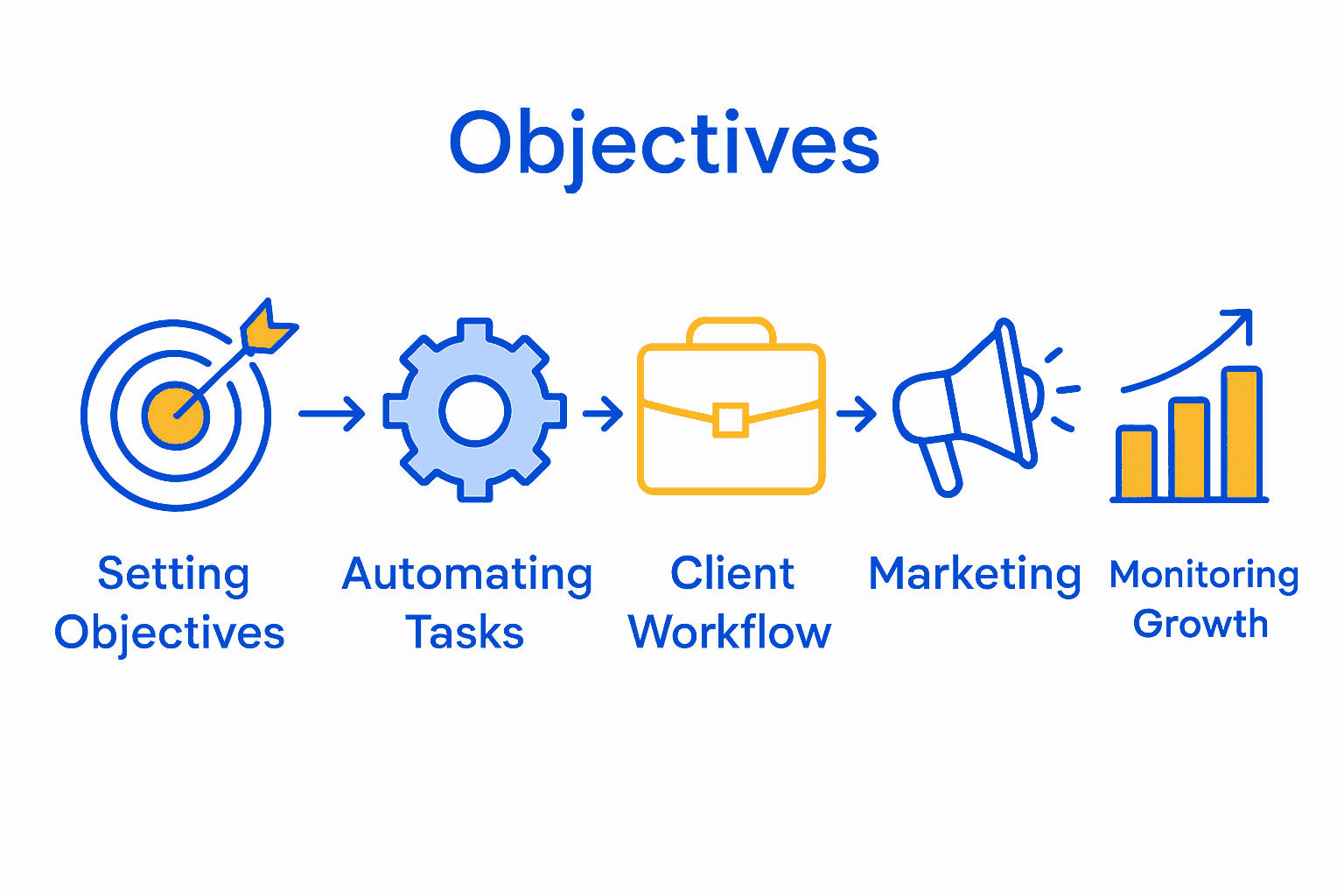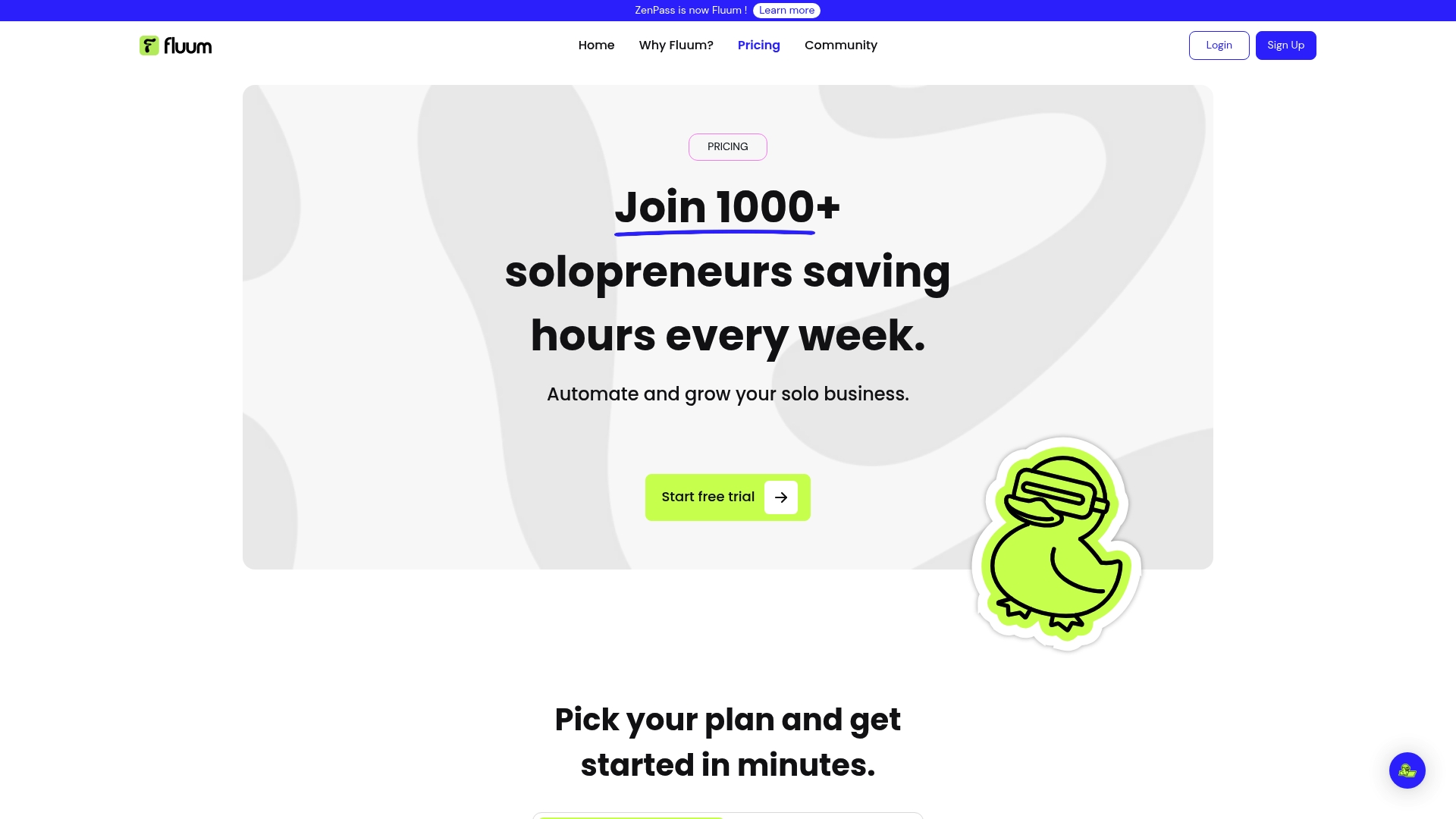
Develop growth is crucial for a solopreneur. Nearly 90 percent of solopreneurs say clear business goals drive real progress. Building a solo venture brings freedom, but also means every decision matters. Without solid plans and efficient systems, it is easy to feel overwhelmed or stuck. With the right steps, you can set focused objectives, harness smart tools, create smooth client journeys, and keep growth steady and trackable from the very first milestone.
Quick Summary
| Key Point | Explanation |
|---|---|
| 1. Define clear growth objectives | Craft precise goals using the SMART framework to ensure measurable and actionable business growth. |
| 2. Automate repetitive tasks | Identify tasks that drain your time and implement automation tools to enhance efficiency and free up resources. |
| 3. Standardize client management workflows | Create templates and systematize processes to ensure a smooth client journey from inquiry to follow-up. |
| 4. Develop a consistent marketing strategy | Define your unique value and utilize targeted channels to attract and engage your ideal clients regularly. |
| 5. Regularly monitor business performance | Create a KPI dashboard to track essential metrics and adjust strategies based on performance reviews and reflections. |
Table of Contents
- Step 1: Define Growth Objectives For Your Business
- Step 2: Integrate Essential Automation Tools Seamlessly
- Step 3: Streamline Sales And Client Management Workflows
- Step 4: Implement Consistent Marketing Strategies
- Step 5: Monitor And Verify Your Business Growth
Step 1: Define growth objectives for your business
Develop growth in a solopreneur business requires crystal clear objectives that transform ambitious dreams into actionable strategies. In this step, you will craft precise growth targets that align with your unique vision and capabilities.
Start by understanding what growth actually means for your specific business. Growth is not just about increasing revenue numbers. It encompasses expanding your client base, improving service quality, creating more efficient workflows, or developing new service offerings. Reflect deeply on what growth looks like through your professional lens.
Begin with a comprehensive self assessment. Review your current business performance metrics like monthly income, number of clients, service delivery capacity, and client satisfaction rates. Ask yourself powerful questions: Where do I want my business to be six months from now? What specific milestones will demonstrate meaningful progress?
Learn more about setting strategic business goals that transform your vision into measurable outcomes. Craft objectives using the SMART framework: Specific, Measurable, Achievable, Relevant, and Time bound. For instance, instead of saying “I want more clients,” define a precise goal like “Acquire 5 new clients in the next quarter who align with my ideal customer profile.”
Pro Tip: Your growth objectives should challenge you without feeling overwhelming. Find the sweet spot between ambitious and realistic.
Document these objectives in a dedicated business plan or strategy document. Break down each goal into smaller actionable steps. This approach transforms abstract aspirations into a clear roadmap you can track and adjust as your business evolves.
Remember that growth objectives are not set in stone. They are living documents that should be reviewed and recalibrated quarterly. Stay flexible and open to pivoting your strategy based on real world results and emerging opportunities.
Step 2: Integrate essential automation tools seamlessly
Automation transforms solopreneur operations from overwhelming chaos into streamlined efficiency. In this step, you will strategically select and implement tools that reduce manual work and free up your creative energy.
Start by mapping out your current business workflows. Identify repetitive tasks that consume significant time like email responses, scheduling, invoicing, and client communication. These are prime candidates for automation. Consider which activities drain your energy and could be handled more efficiently with smart technology solutions.
Learn more about business automation strategies that can revolutionize your solo enterprise. Look for tools that integrate seamlessly with your existing systems. Prioritize platforms offering comprehensive features like client management, payment processing, and marketing automation in one connected ecosystem.
Key areas to automate include:
- Client onboarding processes
- Appointment scheduling
- Invoice generation
- Email marketing sequences
- Social media posting
Pro Tip: Choose automation tools with user friendly interfaces. Complex systems create more work than they solve.
Test automation tools systematically. Start with one or two critical processes and gradually expand. Most platforms offer free trials allowing you to experiment without financial risk. Pay attention to how each tool saves time and reduces your administrative burden.

Remember that automation is about working smarter. The goal is not to replace human connection but to create more space for meaningful client interactions and strategic business growth. Regularly reassess your tools performance and be willing to adapt as your business evolves.
Step 3: Streamline sales and client management workflows
A well orchestrated client management system can transform your solopreneur business from scattered interactions to smooth professional experiences. In this step, you will design workflows that make every client interaction feel personalized yet efficient.
Start by mapping your entire client journey from initial contact to project completion. Break down each interaction point asking yourself critical questions. How do potential clients discover you? What happens after their first inquiry? How do you convert leads into paying customers? How do you deliver services and maintain communication?
Explore effective client management strategies that simplify your professional processes. Create standardized templates for proposals, contracts, welcome packets, and follow up communications. These templates ensure consistency while saving precious time during client interactions.
Develop a systematic approach to lead management. Create a clear process for:
- Initial client consultation
- Proposal development
- Contract signing
- Onboarding procedures
- Service delivery
- Post project follow up
Pro Tip: Implement a customer relationship management system that tracks all client interactions in one central location.
Consider integrating digital tools that automate communication and tracking. Look for platforms allowing you to send automated yet personalized emails, schedule appointments seamlessly, and track client progress without manual intervention.
Remember that streamlined workflows are not about removing human touch. They are about creating space for more meaningful client relationships. By reducing administrative friction, you free up energy to deliver exceptional service and build deeper connections with your clients.
Step 4: Implement consistent marketing strategies
Marketing is the lifeline that transforms your solopreneur business from a hidden gem into a recognized brand. In this step, you will develop a strategic approach to marketing that attracts ideal clients consistently and authentically.
Begin by understanding your unique value proposition. What makes your service different? Who are the clients you most want to serve? Your marketing strategy must speak directly to these specific people with clarity and precision. Think beyond generic messaging and craft communication that resonates deeply with your target audience.
Learn about building an effective brand messaging strategy that captures your professional essence. Select marketing channels that align with where your ideal clients spend their time. This might include professional networking platforms, targeted social media, industry specific forums, or specialized online communities.
Develop a content strategy that showcases your expertise without feeling salesy. This could involve:
- Regular blog posts
- Informative social media content
- Short educational videos
- Podcast appearances
- Guest writing opportunities
Pro Tip: Consistency matters more than volume. Choose 2 3 channels you can maintain regularly rather than spreading yourself thin.
Create a content calendar to plan and schedule your marketing activities. This helps maintain regular communication with your audience and prevents last minute scrambling. Track which types of content generate the most engagement and adjust your strategy accordingly.
Remember that marketing is about building relationships. Focus on providing genuine value through your content. Share insights solve problems and demonstrate your expertise. Your ideal clients will be naturally drawn to your authentic approach.
Step 5: Monitor and verify your business growth
Growth is not just about feeling successful it is about tracking measurable progress with precision. In this step, you will establish a systematic approach to monitoring your business performance and making data driven decisions.
Create a comprehensive dashboard that captures key performance indicators relevant to your specific business model. This means moving beyond simple revenue numbers and diving into metrics that truly reflect your business health. Track indicators like client retention rates, average project value, time spent per client, conversion rates from initial consultation to signed contract, and overall client satisfaction scores.

Explore advanced business performance review techniques that transform raw data into actionable insights. Set up regular review intervals quarterly or biannually to assess your progress. During these reviews compare your current performance against the growth objectives you established in the first step of this guide.
Identify the most critical metrics for your business. These might include:
- Monthly revenue
- Number of new clients
- Client lifetime value
- Marketing conversion rates
- Service delivery efficiency
Pro Tip: Use digital tools and spreadsheets that automatically calculate and visualize your progress to save time and reduce manual tracking.
Develop a habit of honest self reflection. Numbers tell a story but they do not capture the entire picture of your business journey. Ask yourself qualitative questions. Are you enjoying the work? Are your clients getting exceptional value? Are you moving closer to your long term vision?
Remember that growth is not linear. Some quarters will show explosive progress while others might feel stagnant. Stay patient and persistent. Use data as a guide not a judgment. Celebrate small wins and learn from periods of slower growth.
Here’s a summary of the five essential growth steps:
| Step | Focus Area | Key Actions |
|---|---|---|
| 1 | Define Growth Objectives | Set SMART goals Assess current metrics Document targets |
| 2 | Automate Operations | Identify repetitive tasks Select automation tools Test and integrate |
| 3 | Streamline Client Management | Map client journey Create templates Systematize lead process |
| 4 | Consistent Marketing | Clarify value proposition Pick key channels Plan content calendar |
| 5 | Monitor & Verify Progress | Build a KPI dashboard Review performance Reflect and recalibrate |
Move From Overwhelmed to Organized With Fluum
You have set clear growth objectives and discovered how automation, streamlined workflows, and targeted marketing can lift your solopreneur journey. Yet if you still feel held back by scattered tools, missed appointments, and endless admin tasks, you are not alone. Many solo providers struggle to turn plan into action because juggling multiple systems makes real growth almost impossible to sustain.

Fluum is designed to bridge every gap identified in this growth guide. Our all-in-one, AI-powered platform automates your sales funnels, client management, booking, payments, and marketing with easy templates and smart integrations. You get everything you need to track growth, engage clients, and free up your time in one place. Join other wellness, coaching, and consulting professionals who have transformed their day-to-day with seamless solutions for every step outlined above. Ready to act now and turn your business plan into reality without complexity or tech hassle? See the full feature set and pick your plan at Fluum Pricing. Take control of your growth path today at https://fluum.ai/pricing.
Frequently Asked Questions
How do I define growth objectives for my solopreneur business?
To define growth objectives, start by reflecting on what growth means for your business, going beyond just revenue. Create SMART goals like “Acquire 5 new clients in the next quarter” to provide clear and actionable targets.
What automation tools should I consider for streamlining my workflows?
Consider automation tools that can handle repetitive tasks such as email responses, appointment scheduling, and invoicing. Identify one or two critical processes to start automating, which can help you save significant time and energy.
How can I create an effective client management workflow?
Develop a systematic client management workflow by mapping out each step of the client journey from initial contact to service delivery. Use standardized templates for proposals and contracts to ensure consistency and save time during client interactions.
What key elements should be included in my marketing strategy as a solopreneur?
Include your unique value proposition and focus on the specific audience you want to attract in your marketing strategy. Choose just 2-3 channels where your ideal clients spend their time, and develop a content calendar to maintain consistent engagement.
How do I monitor and verify business growth effectively?
To monitor business growth, create a KPI dashboard that tracks metrics like client retention rates and monthly revenue. Regularly review these metrics quarterly to assess your performance against the growth targets you set earlier.
What should I do if growth feels stagnant?
If growth feels stagnant, conduct an honest self-reflection on your business practices and client satisfaction. Identify any areas for improvement, and be prepared to recalibrate your objectives based on your insights for the next quarter.
Recommended
- Fluum | Effective Stress Management Techniques for Busy Professionals
- Fluum | How to Onboard Clients Effectively for Lasting Success
- Fluum | Master Managing Multiple Projects for Success
- Fluum | Build Your Brand with a Branding Builder in 2025
- Fluum | 7 Customer Retention Examples to Boost Your Business



